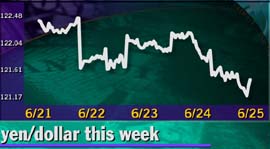|
Bond keeps above the red
|
 |
June 25, 1999: 3:25 p.m. ET
Morning rally proves fleeting as Fed fears overcome bargain hunting
By Staff Writer Robert Scott Martin
|
NEW YORK (CNNfn) - U.S. bonds hung stubbornly onto the shreds of their first rally in over a week Friday, but the market's overwhelming fear of rising interest rates spooked most bargain hunters out of their morning buying spree.
Shortly before 3 p.m. ET, the benchmark 30-year bond was up a narrow 2/32 of a point in price at 87-23/32. The yield, which travels in the opposite direction from the price, ticked down to 6.15 percent.
Activity remained thin, exaggerating the apparent impact of the bond's already razor-thin gains, which represented the market's first up day since Thursday of last week. In total, the bond lost 2-6/32 in price this week, while the yield soared a full 18 basis points, or 0.18 of a percentage point.
Most significantly, the yield hit a trading high of 6.19 percent Thursday, its highest level since late 1997 and within sight of a key technical support level of 6.25 percent.

Traders said the morning's round of bargain hunting had sputtered out in the overwhelming market gloom, especially in the face of stronger-than-expected gross domestic product (GDP) statistics and the looming shadow of next week's interest-rate setting Federal Reserve meeting.
According to the second and final revision of the first-quarter GDP, the U.S. economy grew at a rate of 4.3 percent in early 1999, edging past both the previous estimate of 4.1 percent and the bond market's forecast of 4.2 percent.
A rising implicit price deflator, a broad gauge of inflationary pressures, had a more direct impact on the inflation-wary bond market. The deflator rose 1.5 percent in the quarter, again outpacing the previous estimate and investors' expectations of 1.4 percent.
One eye on inflation
Economic growth naturally generates inflation, one of the natural enemies of bonds and other fixed-income securities. High inflation not only depresses the real value of bonds' pre-set returns, but it increases the likelihood that the Federal Reserve's Open Market Committee (FOMC) will keep its bias toward higher interest rates in future meetings.
Most investors now believe the FOMC will raise rates at least once this year, tightening the funds rate by 25 basis points, or a quarter percentage point, to 5 percent when it meets Tuesday and Wednesday.
"We're in this volatile trading range right now until we see what the Fed's going to do," said Dan Veru, stock analyst at money manager Awad & Associates. "A quarter-point rate increase is clearly built in (bond yields). You really want to see what further direction the Fed's going to give from that point -- whether this is the first of several rate hikes, which I think would be a negative for the market."
The threat of several rate hikes -- or a few more- intensive increases -- has driven the bond market into a full-fledged retreat this week, pushing the benchmark yield to a 19-month high of 6.19 percent Thursday as prices erode.

Dollar flees bonds, stocks
The dollar, meanwhile, was back on the defensive, still smarting from Thursday's simultaneous declines in the U.S. bond and stock markets as overseas flows of cash into the dollar-denominated securities ebbed.
In late U.S. trading, the euro had climbed to $1.0432 after hitting two-week highs overnight, while the dollar slipped to 121.38 yen from its previous close of 121.91.
Although traders noted that the dollar's gloom had spread from Wall Street and the Treasury market, technical factors also were to blame as many speculators found themselves caught long on dollars ahead of next week's Fed meeting and the end of the financial quarter.
The specter of Japanese currency intervention kept dollar/yen relatively subdued, however. The Bank of Japan (BOJ) has aggressively sold yen on four separate occasions this month in an attempt to keep that currency from appreciating too quickly. A strong yen would endanger Japan's still-tentative economic recovery by hurting exports, leaving the nation's key manufacturing sector heading back into decline.
On Friday, "Mister Yen," Japanese Vice-Finance Minister Eisuke Sakakibara, reminded yen bulls yet again that the BOJ is watching and ready to push the yen down should it gain too much on the dollar or other currencies. 
|
|
|
|
|
 |

|

